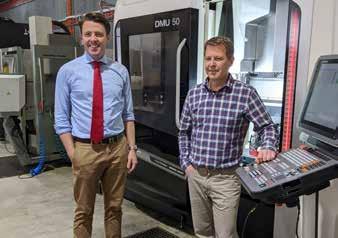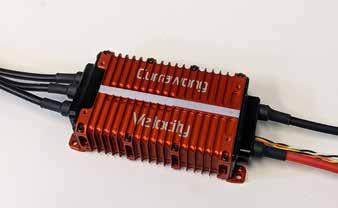
7 minute read
COMPANY FOCUS
from AMT FEB/MAR 2021
by AMTIL
Currawong Engineering – Powering UAVs worldwide
Receiving a government grant last year has enabled the Tasmanian manufacturer Currawong Engineering to expand its electronic production and plant equipment, hence boosting its US export opportunities. By Carole Goldsmith.
Currawong Engineering was awarded $150,000 from the Federal Government’s Centre for Defence Industry Capability (CDIC) Defence Global Competitiveness Grant last September. A great boost for the business, the grant has enabled the Huntingfield-based firm, a world leader in the design and manufacture of powertrain solutions for the unmanned aerial vehicle (UAV) industry, to purchase specialist plant equipment in order to expand its electronic production capability. This will ensure improved quality, reliability and lead times for its electronic speed controllers. Ultimately the CDIC grant will boost Currawong’s North American export opportunities, where most of its sales are currently made. Gavin Brett, the founder, CEO and principal development engineer at Currawong, advises that the total project cost is estimated to be around $300,000, with up to 50% provided through the CDIC grant. “The first item that we purchased (for this project) is an automatic optical inspection machine to inspect Printed Circuit Board (PCB) assemblies,” he explains. “Next, we are buying an electric component replacement machine and a reflow oven. This increased production capability will be essential to fulfill our global customers’ orders promptly. “Commercially, if you need a grant, you need it now. The wheels of most government grants move very slowly and you need to wait a long time for most of these grants to be awarded. Also, they won’t pay for things that you have already spent money on. “On the other hand, the CDIC grant awarding process is very fast. They advise you quickly, so you can plan your equipment purchases. That is very helpful to small to medium businesses like ours and we were really grateful to receive the grant.” A global market, growing fast
Brett says that the global UAV market is a multi-billion market and it’s growing very rapidly. In October 2020, German on-line statistics portal Statista reported that the UAV global market is expected to grow at an annual growth rate of around 9.6% between 2018 to 2029 to reach US$70bn worldwide. Military and defence applications account for most of the UAV markets. Currawong works closely with its three US global partners. Power4Flight (P4F) in Oregon distributes Currawong products in Canada and the US. HFE in Tucson, Arizona, is a partner in propulsion system development with Currawong and an established user of its Electronic Fuel Injection (EFI) systems and components. Cobra Aero, based in Hillsdale, Michigan, is collaborating with P4F and Currawong on a clean-sheet, advanced UAV engine That will offer true aerospace technology to small to medium UAVs’ propulsion. Brett explains that there are numerous benefits in replacing carburettors with EFI for fuel delivery on UAV engines: “Achieving these benefits requires a comprehensive integration and calibration for each engine installation. As a long-established specialist in UAV power train systems, we have the extensive experience and suitable equipment to undertake these tasks.” Currawong’s UAV powertrain features an aerospace-grade fuel injection system that ensures optimum engine performance and reliability over a wide range of operating conditions. The system also includes a low-noise exhaust manufactured by Cobra Aero, plus an integrated generator and power supply. “EFI-equipped engines generally provide higher power and torque output than a carburetted version of the same engine,” says Brett. “It is difficult to optimise power and torque across a wide range of engine speeds with carburettors. However, EFI systems are capable of optimising air/fuel ratios and ignition timing over a wide range of operating speeds.” Currawong also designs and manufactures the enclosure used for the 250W-power supply provided by its fourth partner Millswood Engineering, an Adelaide business that produces UAV generators and UAV flight safety systems.
A Bluebird Aero Systems' UAV fitted with a Currawong Engineering powertrain system
Innovative new products
Currawong’s mechatronic products are sold to UAV producers across 10 countries around the world. Mechatronics combines several types of engineering: electrical, software and mechanical. Brett describes some of the exciting new innovative products that Currawong is currently working on. “We designed and manufactured a motor controller for the UAV industry to drive propellers for electronic products,” he notes. “Our Velocity electronic speed controller (ESC) provides high-power, high-reliability, brushless motor control for UAV power systems globally.

Currawong Engineering founder and CEO Gavin Brett (right) with Senator Jonno Duniam during the announcement of the CDIC government grant. Currawong’s workshop in Huntingfield, 15 minutes south of Hobart.
Currawong’s newly released Velocity HT electronic speed controller.
“The first version that we designed and manufactured is being used by every major US UAV producer. Then we made an improved version with updated electrical work and there has been a lot of demand for it from our global partners and customers.” The Corvid-50 engine is among the Currawong range of EFI powertrain solutions and an upgraded version of the system was released in May 2019. This engine is based on the Desert Aircraft DA-50 engine and features a custom crankcase, crankshaft, throttle body, starter generator, inlet manifold and integrated isolation mount. It comes with Currawong’s robust EFI system and optional low-noise exhaust. More than 700 of these Corvid-50 EFI systems have been used on Honeywell’s T-Hawk micro air vehicle. Currawong is also working on another interesting new project to produce small electronic generators for soldiers to carry around and charge their equipment. Following a career in engineering

Brett believes his particular skill is his ability to work in multiple engineering disciplines, an area of expertise that is extremely relevant to the mechatronic products that are designed and manufactured at Currawong. After graduating as a mechanical engineer at RMIT University in Melbourne in the mid-1990s, he worked at GM Holden in Melbourne as an engine development engineer. This was followed by a five-year career (three years as engineer and two as chief engineer) at Aerosonde in Melbourne, now part of Textron Systems. Brett’s time at Aerosonde gave him extensive experience in the UAV engineering field, and it equipped him with invaluable knowledge when he would later start his own business. In July 2003, Brett and his wife Claire needed a change of scenery and decided to start a new life in Tasmania, a dream they had held for some time. Armed with a couple of suitcases and their car, they boarded the Spirit of Tasmania ferry at Port Melbourne, bound for Devonport. They initially settled in Hobart where Claire found a job first, working in environmental management for the Tasmanian State Government. “I enjoyed some outdoor adventures and then I decided to knuckle down and start designing a camera gimbal (a pivoting camera support),” says Brett. “I licenced the mechanical design of that product to Cloud Cap Technology, which was sold as the TASE (the-all-seeing-eye) imaging system. This is still used today in security for defence and other companies.” In January 2005, Brett founded Currawong: “After moving from Melbourne, I had limited money and my dad lent us some to buy our first machine, a Haas TL-1 lathe, which I still have and use on most days. I was working from home, and when Claire became pregnant a few months later, we decided that it was not good having machine tools under the house, so I leased that first factory in Kingston.” In 2008 Ken Hosking invested in the company and subsequently played a valuable role in its business development and financial oversight. Two years ago, Currawong moved to its new factory in Huntingfield, 15 minutes south of Hobart. By that time the company had run out of space at its previous site, having already acquired seven large machine tools. The Huntingfield site is considerably larger than its first factory. “It was very stressful moving, as large machine tools really don’t like being moved, but they survived,” recalls Gavin. “We now have a very well-equipped workshop including a range of lathes, millgrinding systems and a specialised laser-welding machine. Our latest machine is a DMG MORI DMU 50 GEN 3 five-axis machining centre, which we use extensively.” Claire, who graduated as a Chemical Engineer at Monash University in the mid-1990s is Currawong’s Finance Manager. She has been handling the company’s finances since the business started – very efficiently according to Brett. When asked why Claire is not working in chemical engineering, Gavin explains: “We don’t have chemical engineering here at Currawong and many engineers often move into management like Claire has.” Brett spends his busy days managing the business and assisting employees to do their job: “They know what to do and they know that I am here to help them when required. We have 16 employees, six of whom are engineers, plus we have machinists and electrical technicians, all fully trained in the work we do. “For our long-term plans, we see huge potential in our electronic speed controllers and our hybrid engine technology. Currawong has invested heavily in R&D activities and is now a world leader. UAVs equipped with hybrid electric/gasoline engines offer a battery alternative to drastically increase flight time.”
www.currawongeng.com











